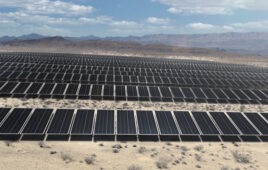 Update 02/07/2023: Gov. Tim Walz said he is signing the bill into law today.
Update 02/07/2023: Gov. Tim Walz said he is signing the bill into law today.
On February 3, the Minnesota State Senate passed the 100% Clean Energy Bill (Senate File 4) and sent it to Gov. Tim Walz’s desk.
The legislation mandates a transition to 100% carbon-free energy by 2040 and marks a crucial milestone on the road to equitable, economy-wide decarbonization. Utilities will also need to increase the amount of their electricity that’s generated from renewable energy sources to 55% by 2035.
With the governor’s signature, Minnesota will join 10 other states with commitments to 100% clean or renewable energy.
The bill will also drive significant advancements in environmental justice. By requiring utilities and energy regulators to direct proportional benefits to communities shouldering the heaviest burdens of climate change, Senate File 4 will be instrumental in reducing environmental health disparities and relieving unjust energy burdens for families across the state.
“Despite the work that remains ahead of us, the 100% Clean Energy Bill brings us closer than ever to a renewable, resilient Minnesota that puts people at the center,” said Jenna Warmuth, Vote Solar Midwest regional director. “I urge Governor Walz to sign the 100% Clean Energy Standard into law as soon as possible and add Minnesota to the growing list of states leading the way through 100% clean energy commitments.”
News item from Vote Solar. Updated with information from Environment America at 2:35 p.m. ET.





I support a goal of 100% clean energy by 2040 in Minnesota. I also realize the bill is at a high level without details on mandating energy storage or distributed solar, for example. Other states have realized that to achieve 100% clean energy; they need energy storage and distributed solar targets to execute clean energy commitments.
According to the Clean Energy States Alliance, a bipartisan coalition of state energy agencies, including our Department of Commerce, there are 4 states with similar goals to ours of becoming carbon-free by 2040. As you point out, our Minnesota utilities must be 80% carbon-free by 2030, 90% by 2035, and 100% by 2040.
Connecticut has a similar goal of 100% carbon-free electricity by 2040. The Connecticut Department of Energy and Environmental Protection (DEEP) issued a report, “Pathways to achieve a 100% zero carbon electric sector by 2040” in December 2020 that showed energy storage is needed to balance out the variability of renewables. The report states, “With respect to the state’s energy supply, battery storage located behind the customer meter can provide for increased on-site consumption of distributed solar.”
Connecticut estimates more than 1,000 MW of energy storage capacity is needed starting in 2031 to complement its installed 416 MW of distributed solar and 45 MW of distributed fuel cells.
Under the Climate Leadership and Community Protection Act (CLCPA) in New York, to reach 100% carbon free electricity by 2040, the Governor announced a goal of 10,000 MW of distributed solar by 2030 in December 2021. On top of that, the Governor doubled the energy storage target from 3,000 MW to 6,000 MW in January 2022. I don’t know how Minnesota will achieve 100% clean energy by 2040 without energy storage or a distributed solar target.
Lastly, in addition to Connecticut and New York, Nebraska has net-zero carbon emissions by 2040 for its publicly owned utility – Lincoln Electric System and Oregon aims to reduce greenhouse gas emissions from baseline levels by 2040. According to the Northwest Power and Conservation Council, “Oregon has a storage mandate for the two largest investor-owned utilities of 5 MWh each by 2022 at a minimum, and up to 1% of 2014 peak load (HB 2193).” I suspect the storage mandate is less because of Oregon’s access to hydropower. According to the U.S. Energy Information Administration (EIA), in 2020, 50% of Oregon’s electricity generation came from hydropower.
The bottom line is that we need a target for distributed generation like energy storage and distributed solar to meet 100% clean energy by 2040.
Oregon’s storage mandate was adopted in 2015, when there weren’t necessarily compelling rationales to deploy storage in the Oregon market. The hope was it would pave the way to a better understanding of the benefits storage can bring to the grid. Now, there’s no need for a mandate. Storage is coming because it’s the only way a solar- and wind-dominated grid can work.